As a type of crane, overhead cranes have a wide range of applications, and are even more popular in Pakistan. Among the crane types sold by Dongqi Crane in Pakistan in the past 2021, overhead cranes accounted for one-third of the sales volume. . As a professional crane supplier, Dongqi Crane can design different types of overhead cranes for Pakistani customers according to different working environments. If you have any questions about the overhead crane, you can leave a message on the website or tell us by Email: sales010@cranesdq.com
Dongqi crane projects of overhead crane in Pakistan
The overhead crane are designed to meet the industrial lifting requirements. As an overhead crane supplier and manufacturer, Dongqi Crane can supplier various types of overhead cranes for various industries in Pakistan. Besides overhead crane, Dongqi is also able to provide gantry crane, jib crane, and electric hoist, electric winch, etc, for Pakistan market for material handling.
Overhead cranes can vary so much in terms of specifications and configurations. No two crane builds are exactly alike! A crane that worked in a similar building structure, or similar lifting application, may not be the best crane for your facility or your application. So, selecting the right type of crane for your business is critical to maximizing efficiency, streamlining workflow, and getting the best bang for your buck.
5 ton single girder overhead travelling crane for sale Pakistan
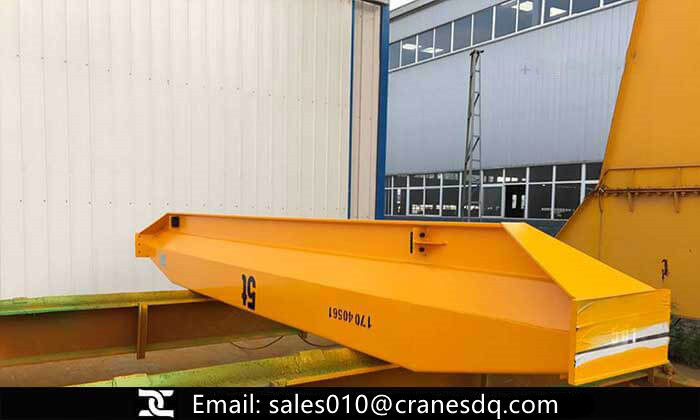
Main girder of 5 ton single girder overhead travelling crane
5 ton double rail electric trolley for FEM overhead crane in Pakistan
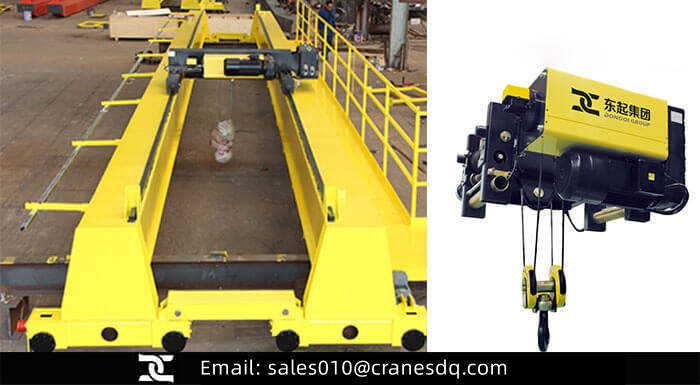
5 ton Fem overhead crane and FEM electric hoist
20 Ton Overhead Grab Crane for Scrap Handling Solution in Pakistan
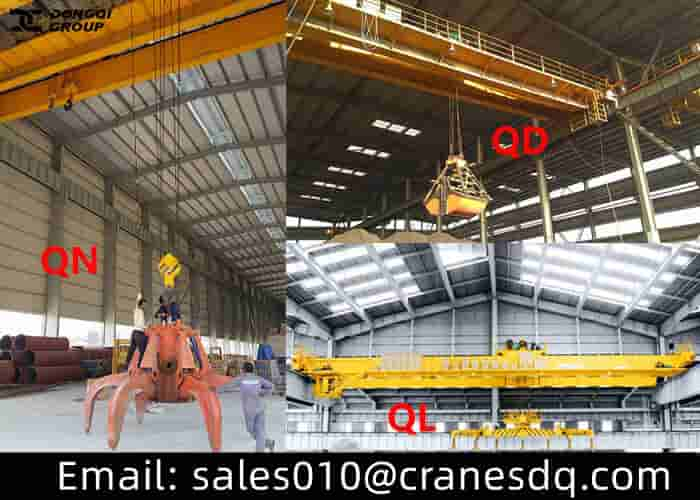
20 Ton Overhead Grab Crane
7 sets double girder cranes installation Pakistan
Overhead crane one stop solution for Pakistan steel mills / plants. 50/20T Ladle Cranes, 20+20T Double trolley cranes, QD15/10T & 10 ton Double girder overhead crane for steel mill installed in Pakistan. One stop crane solution save your time & engineer, ensuring quality and service.
Types of steel mill eot cranes for pakistans
- QD15/10T traditional double girder hoist winch overhead crane, 3 sets
- QD 10 ton Double girder overhead crane, 1 sets
- 20+20T Double trolley overhead cranes 1 sets
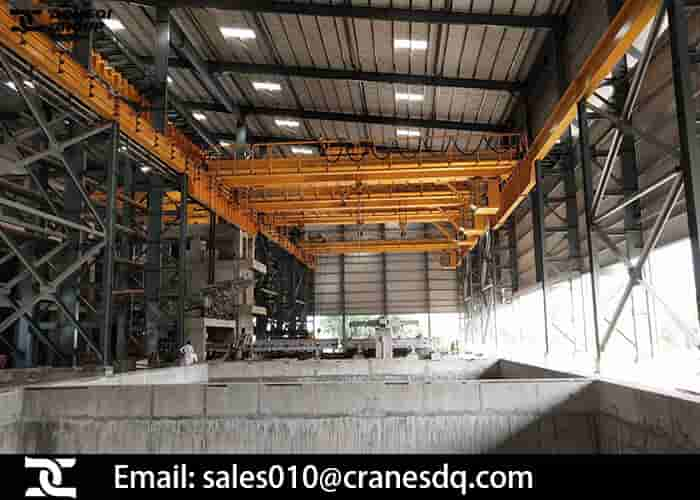
Types of Overhead Cranes Supplying Pakistan
Single Girder vs. Double Girder Bridge Cranes
An overhead bridge crane can be configured in a single girder or double girder design. In simple terms, a bridge girder, or beam, is the support structure that allows the trolley and hoist to move from side-to-side along the bridge. The trolley is used to precisely position the hoist prior to raising or lowering a load.
To a degree, both single and double girder cranes are equal in strength and durability. The main difference between the two comes down to hook height, or how high above the ground your hoist can lift. A double girder crane can provide more hook height because the hoist is placed on top of the girders, instead of below them.
There are some instances where a double girder or single girder configuration may be the better option. We’ll discuss some of these instances below:
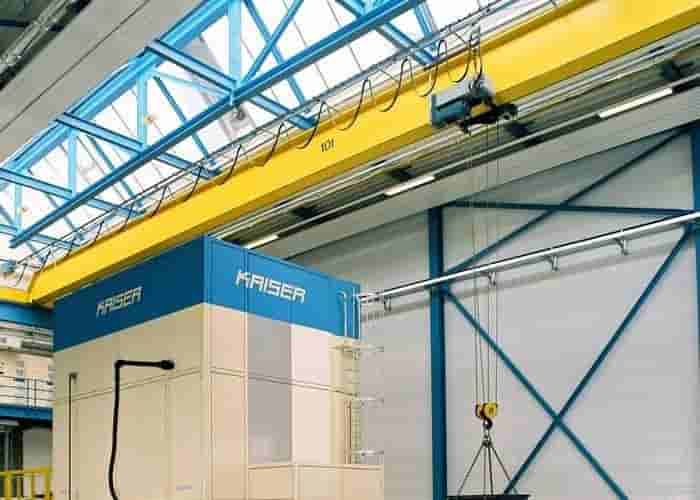
Single Girder – The bridge consists of one girder beam supported on each side by an end truck. The trolley and hoist are most commonly underhung—meaning they run on the bottom flange of the bridge. They also tend to be less expensive due to:
- Only one girder is required to move the trolley
- Reduction in freight expenses
- Faster installation
- Simpler hoist and trolley design
However, in the instance that a crane needs to handle more than 15 tons, or the span is more than 65 feet, a double girder configuration may be the better option.
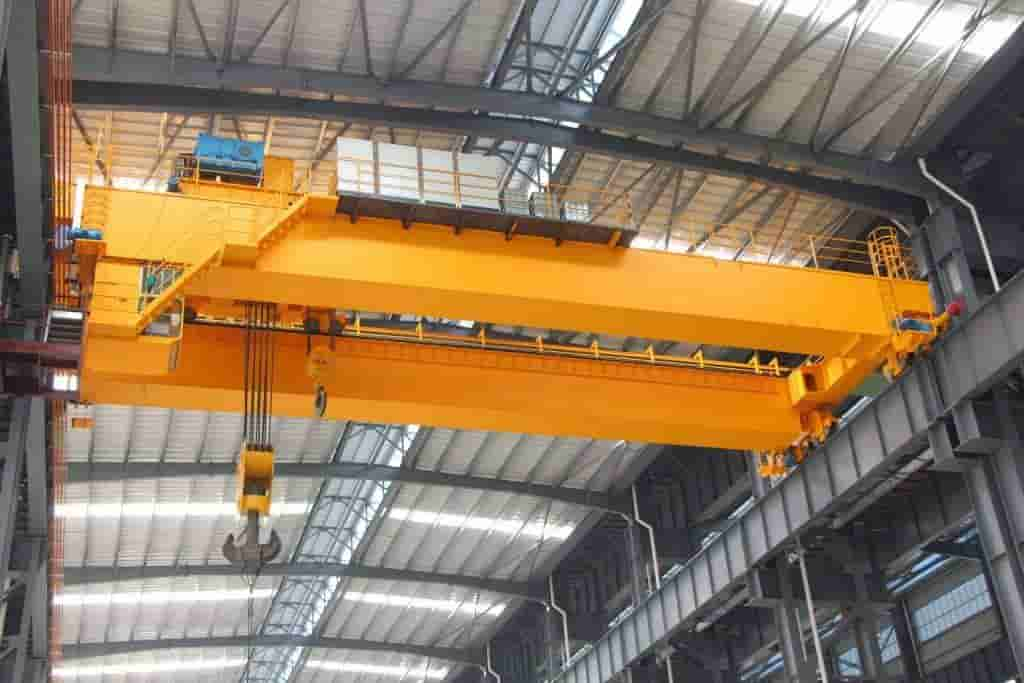
Double Girder – There are two girder beams that make up the bridge, and they are supported by an end truck on each side. The trolley and hoist run on a rail installed on top of the bridge girders. Double girder cranes are recommended for heavier-duty applications where the crane has to handle more than 15 tons, or the span is more than 65 feet.
Double girder cranes are the best option when the crane needs to be customized with things like walkways, cabs, magnet cable reels, or other specialized equipment. And on a top running design, they can provide more lifting height since the hoist isn’t hanging underneath the beam.
Top Running vs. Under Running Cranes
When it comes to defining clear differences between bridge cranes, you will want to consider if you require a top running or under running crane.
On a top running crane, the bridge runs on rails along the top of the runway beams.
On an under running, or underhung crane, the bridges are supported by the bottom of the runway beams and the wheels run along the bottom of the lower beam flange.
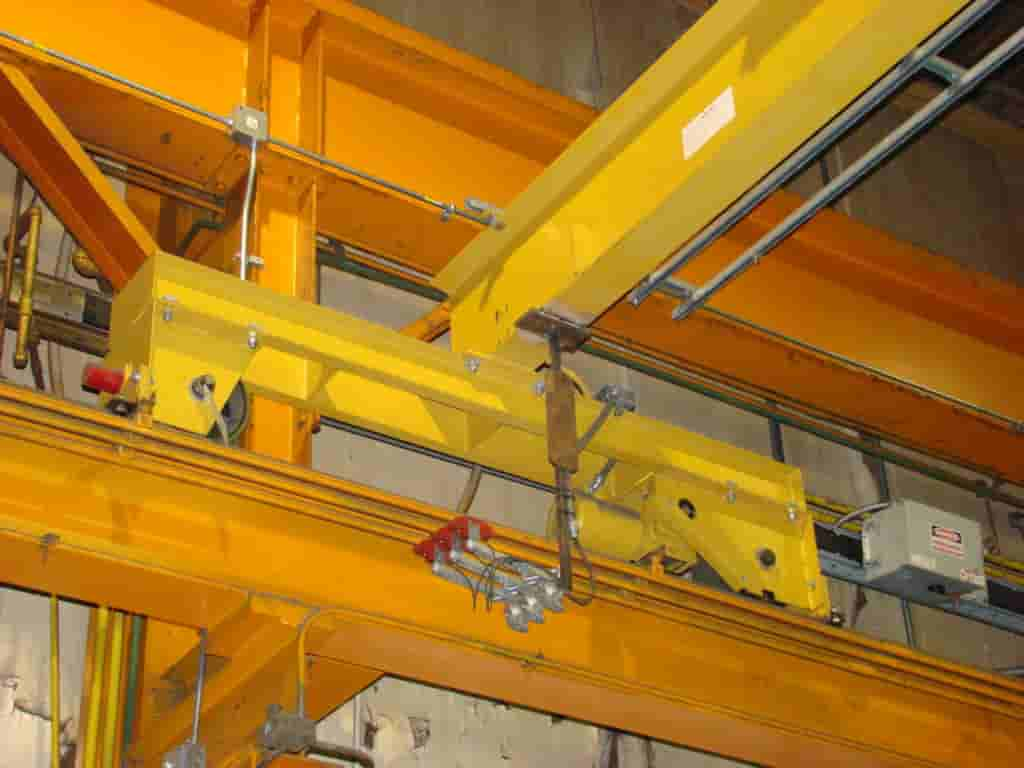
Top running cranes – These cranes have no limiting capacity—meaning they can be built to go from small capacities to very large capacities. They include a rail installed on top of each runway, and the bridge wheels move on the rail instead of the bottom flange of the runway beam. These cranes are supported by the building structure or runway support columns, or sister columns, and are ideal for moving extremely heavy loads.
Top running cranes can be designed in a single-girder or double-girder configuration:
- Single girder top running benefits:
- Typical load capacity: .25 – 20 tons
- Typical span: under 65 feet
- Typical service: light
- Low deadweight
- More overhead space
- High speed
- Lower production cost / lower overall price
- Double girder top running benefits:
- Typical load capacity: 20-400 tons
- Typical span – over 65 feet
- Typical service – Heavy
- Ideal when extremely high hook height is necessary
- Better hook height
- Most overhead space
- More lift
- High speed
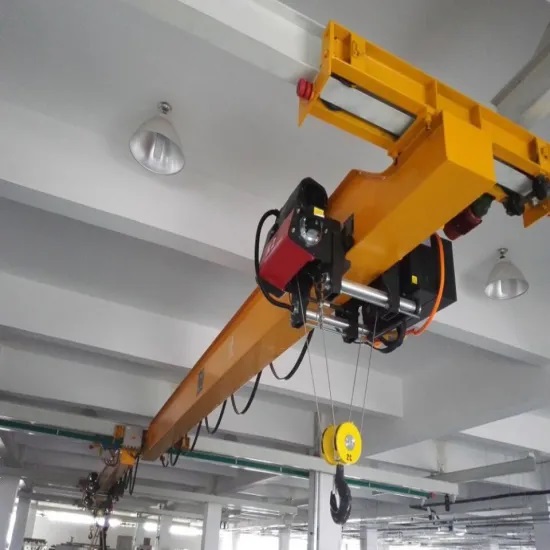
Under running cranes – often called “underhung,” because the crane wheels are supported by the bottom flange of the crane runway beams acting as the crane rail. These types of cranes can allow you to maximize your facility’s floor space for production and storage of material because they are supported from the ceiling trusses or the roof structure. Or, they can be designed to utilize an existing support structure (if adequate), or run on a newly-engineered support structure.
- Typically designed for lighter service / lower capacity applications
- It can become impractical and expensive to engineer an under running crane to make it a high-capacity piece of equipment
- Offers excellent side approaches and maximize utilization of the building’s width and height when supported by roof or ceiling structures
- Hook height is less than top running because bridge and hoist hang underneath runways
Patented Track vs. Structural I-Beams
When it comes to under running cranes, there are two types of beams that are used for the trolley to run on—either a structural I-Beam or an engineered type of beam that is referred to as “patented track.” Patented track is an option versus using a structural I-beam because it is specifically designed for crane operation and is stronger, more durable, and more consistent. An I-beam is rolled from softer, mild steel and has a beveled bottom flange that prevents the trolley wheels from making a constant balanced contact with the beam. This can cause unbalances, uneven wear, and shorten the life of the track section.
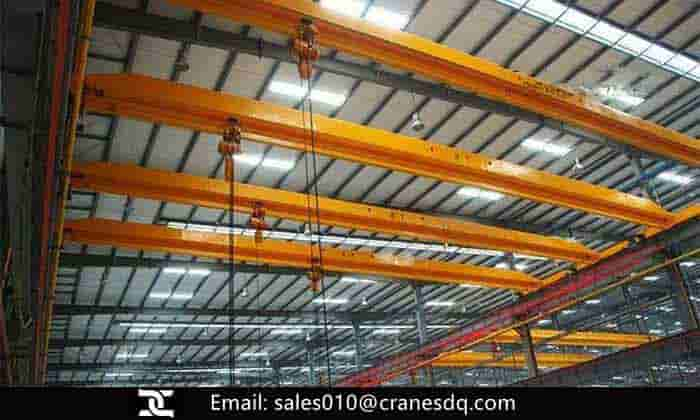
Traditional I-beam crane solution
Process Cranes vs. Modular Cranes
Bridge cranes fall into two categories based on their service, capacity, and environment. Common terms for the two different types of cranes are “Process” cranes and “Modular” cranes. We’ll explain what each of these means in greater detail below:
Process cranes – A process crane is built for a specific need and these types of cranes are heavy-duty (mainly Class D & E cranes) and in constant, or near-constant, operation. They’re typically a top-running, double girder design and have a lot of engineering built-in to perform high capacity lifts, or to perform a very specific task over and over again. Process cranes can be found in places like automotive assembly plants, steel mills, container yards, lumber mills and can perform anywhere from 10-20 lifts per hour at around 50-75% of their rated capacity.
Modular cranes – Often referred to as “kit cranes,” modular cranes are typically found in smaller manufacturing facilities, smaller-sized mills, or machine shops, and have a design consisting of a more base-level hoist, trolley, and bridge. They’re economical and affordable solutions to moving material through a facility and don’t normally come with a lot of extra bells and whistles. Kit cranes are typically Class C and are being used at around 40% capacity, but can be bumped up to Class D with extra engineering built-in if the lifting application requires it.
According to different usage scenarios, Dongqi Crane provides customers with special types of overhead cranes. For example, explosion-proof cranes are used in flammable and explosive work scenarios, and different flammable and explosive environments have different requirements for the explosion-proof grade of cranes.
Such as an electromagnetic crane, when the current is turned on, the electromagnet will firmly attract the steel objects and lift them to the designated place. Cut off the current, the magnetism disappears, and the steel item is put down. Electromagnetic cranes are very convenient to use, but they can only be used when there is current. They can be used in scrap steel recycling departments and steelmaking workshops.
Such as grab cranes, overhead grab cranes are dedicated to bulk and granular materials. Conventional configuration of bridge grab crane: cab control, cab split and closed. Each mechanism adopts winding type hoisting motor with resistance speed regulation. Grab overhead crane working level: A6, A7, working environment 20℃~+40℃
How to customize Overhead Crane from China
We are a crane manufacturer located in China, providing crane customization services to global crane customers. If you want to customize a Overhead Crane, you can leave a message on the website or Email: sales010@cranesdq.com, tell us the following information, and our sales manager will contact you
https://www.craneyt.com/overhead-crane-for-sale-pakistan.html
没有评论:
发表评论